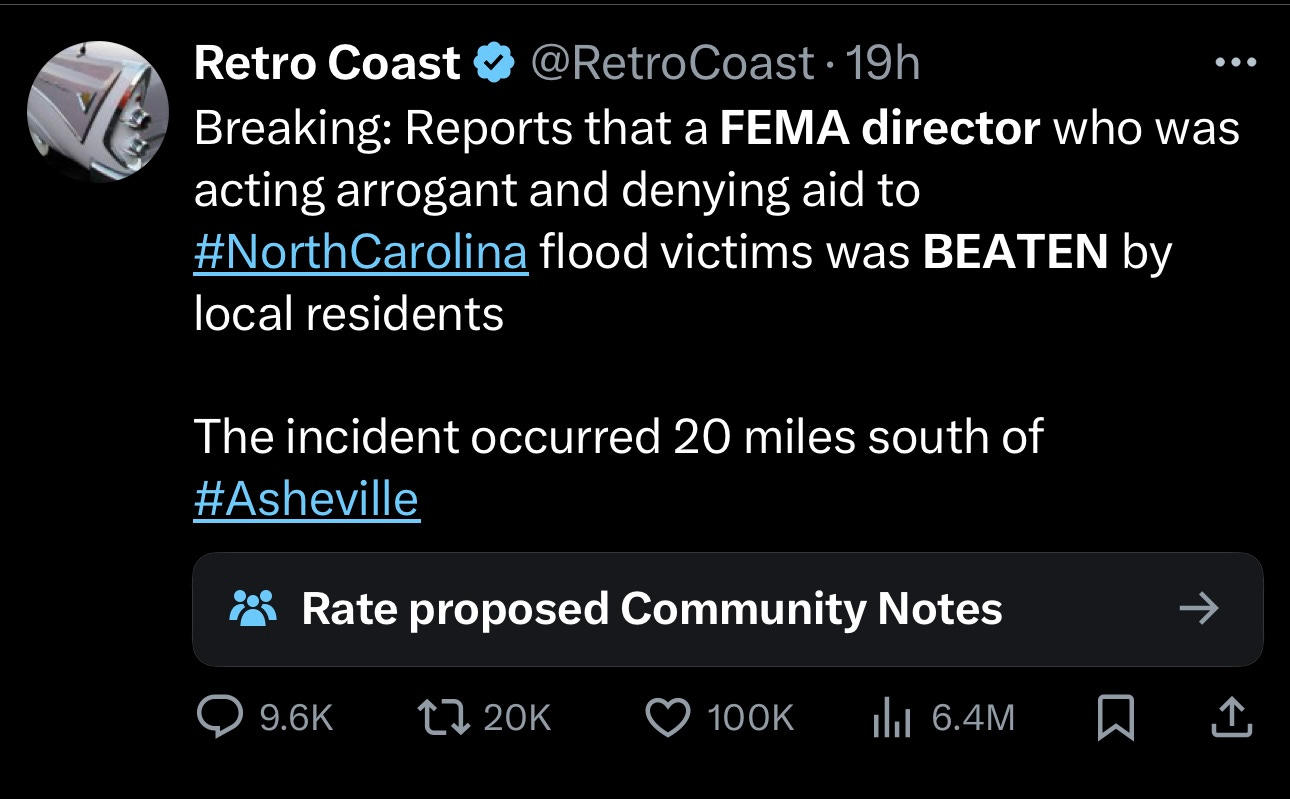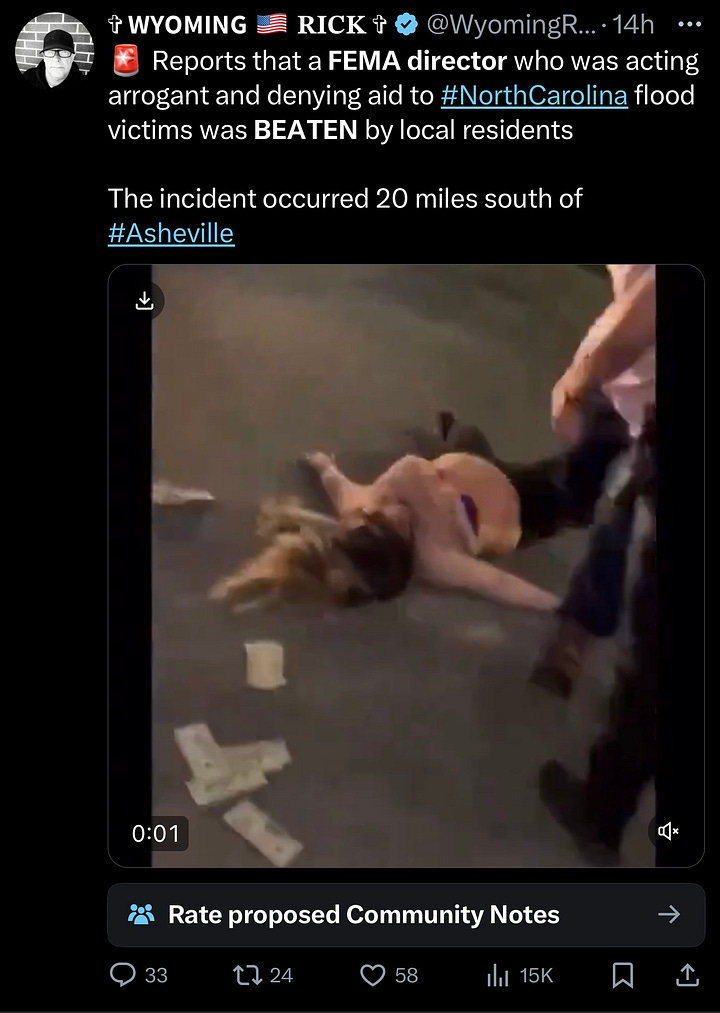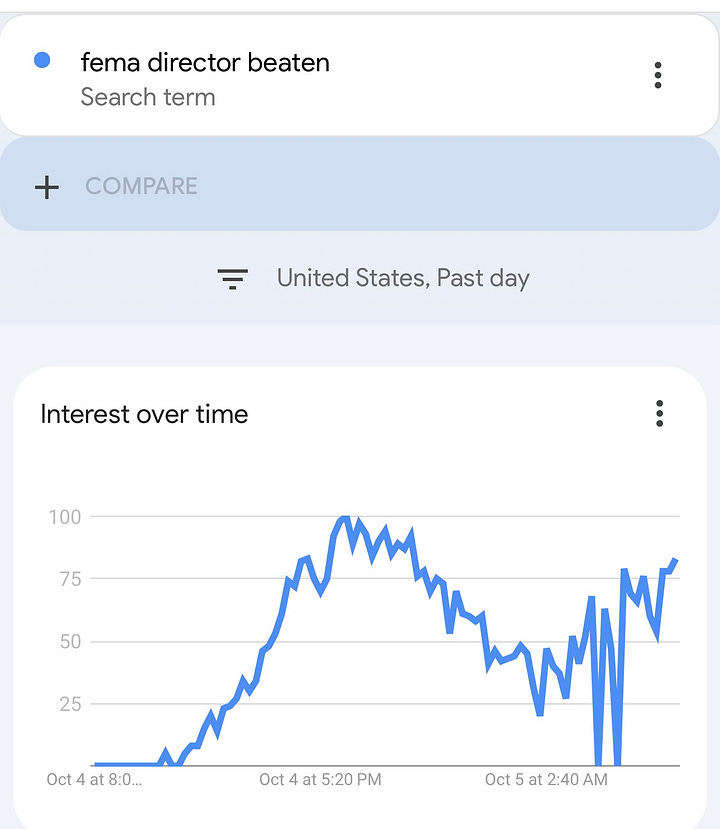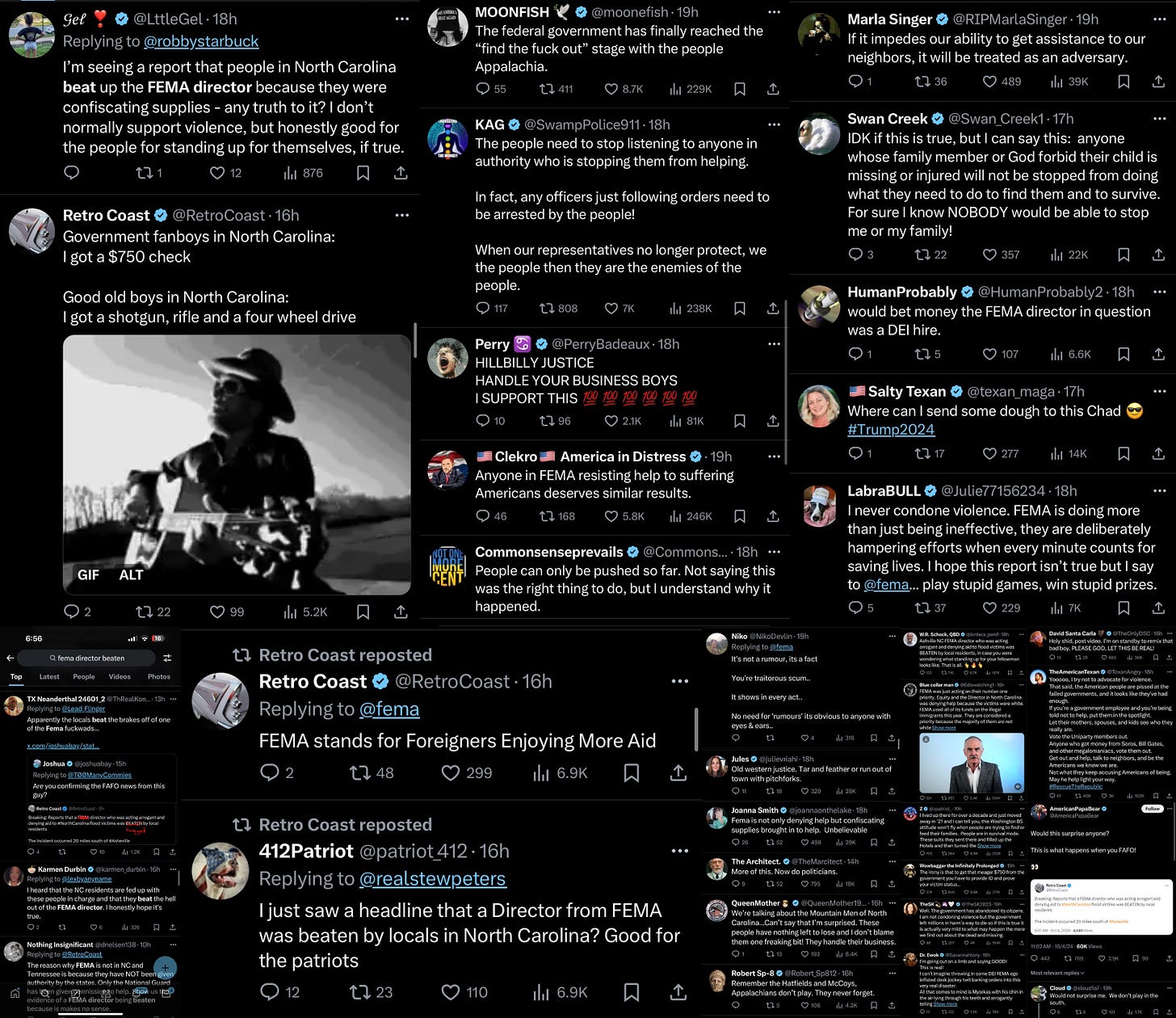How a viral rumor about a FEMA director being assaulted ended in real threats of violence
A reminder of the threat posed by unmitigated data voids.
The latest viral misinformation about the recovery efforts following hurricane Helene in North Carolina is a claim that a FEMA director was physically beaten by locals who were angry about FEMA’s response to the deadly disaster. I dug into this claim soon after it started making the rounds, and thus far I haven’t found any information or sources that corroborate it, but I did find plenty of contradictory evidence disputing its veracity. But mostly, I just found a lot of angry and violent posts cheering on the idea of a federal official being violently assaulted while doing their job — with very little pushback and almost no attempts to figure out if the incident even happened at all.
The unmitigated spread of this unfounded claim provides a startling example of a data void, and a stark reminder of why it is so important to stay ahead of the narrative engineers who are trying to shape our collective memory of what happened by indirectly controlling the information that we see, and, just as importantly, what we don’t see. Most disturbing of all, this incident is one of the clearest examples that I’ve ever seen of how online rhetoric can directly motivate and guide offline violence through the use of storytelling to reframe political violence as not just acceptable, but as a necessary — heroic, even — act of survival carried out by desperate people who are cast as both the victims and the heroes of the story. I’ll get into that more in a future piece, but for right now, let’s look at how this baseless narrative emerged, went viral, and jumped platforms before a single attempt was made to fact-check the story — and what the consequences were of failing to fill that data void with verified information.

The reports of a FEMA director being assaulted appear to have originated with a tweet from a pro-Trump Twitter account, which was shared more than 20,000 times and garnered more than 100,000 “likes” and 6.4 million views in the first 19 hours after it was posted on Friday morning. Several hours later, a pro-Trump meme account followed up on the initial claim with a tweet that repeated — nearly verbatim — what was posted by the first user, but with the addition of a video clip for extra effect. The tweet was clearly intended to make people think that the video — which depicted a woman being violently thrown to the ground, with money falling out of her pockets or purse — was actual footage of the alleged assault of a FEMA director. However, a quick reverse image search from a still-shot of the video shows that the clip is and ally from a 2023 incident in which a security guard threw a woman to the ground outside of a Texas nightclub. Still, the unfounded rumor continued picking up steam online. A couple of hours later, another pro-Trump account tweeted the same video clip, along with a tweet containing the verbatim text from the initial post. In what appears to be an interesting attempt to save face, the user then returned to their tweet a couple hours later and claimed that they had posted the video “for effect only,” as if they weren’t trying to pass the video off as footage of the alleged attack.


Over the course of Friday evening and the early hours of Saturday morning, the claim spread like wildfire through pro-Trump Twitter networks, with many users posting their own versions of the story or commenting on why they think it’s true, despite lacking any evidence. Other users celebrated the alleged assault of a federal emergency management director, and many others commented that they hope it’s true and would like to see it happen to more federal employees, saying they deserve it for their handling of the devastating flooding in North Carolina and other recent natural disasters like the Maui wildfires.
By Saturday morning, the claim had jumped platforms and started circulating on Facebook, Instagram, Tik Tok, and elsewhere. Although it hasn’t gotten much coverage in the media yet, right-wing media outlets like The People's Voice had already run with the story as of Friday night, despite a complete lack of evidence that it actually happened.
Nearly 24 hours after the initial tweet alleging that a FEMA director had been physically assaulted by residents of a town near Asheville, NC, I could only find one published attempt to fact-check the unfounded claim, and it was published in an Indian newspaper that couldn’t verify nor debunk the claim. Of course, not every baseless claim on social media needs to be fact-checked — in some cases, doing so just gives more exposure to the misleading or false information while also adding unnecessary clutter to an already chaotic information environment — but the calculation changes when we’re dealing with violence-related viral social media posts in the midst of recovery efforts for a major natural disaster. At the time of this writing, the phrase “FEMA director beaten” was the 10th most searched item on Google — a metric that is indicative of widespread interest (and even more than that, confusion) about what actually happened or, more likely, what didn’t actually happen.


This discrepancy — between the demand for information on a topic or event, and the supply of credible, relevant, and surfaceable information — creates what is known as a data deficit, which is a specific type of data void that often emerges during breaking news events and crisis or disaster situations. Data voids and data deficits — part of a larger threat that my colleague and I refer to as Informational Dark Spaces — are problematic for a number of reasons, including the fact that they are prime targets for exploitation by bad actors looking to spread disinformation by jumping on highly specific or obscure keywords and phrases, spreading them on social media, and then flooding websites with false and misleading information containing those keywords. Similar patterns of exploitation have also been used by extremists and cyber criminals to boost the visibility of hate content and malicious links. These problems are exacerbated by recommendation algorithms and autocomplete search boxes, which can be manipulated by bad actors and ultimately lead individuals down troubling rabbit holes when all they set out to do was search for information about a breaking news event.
By Saturday morning, what started as a fictional account of a FEMA director being assaulted had spiraled into actual threats of violence.
Research shows that data voids increase the likelihood that an individual will encounter mis- or disinformation while searching for information on search engines like Google. Even more troubling, not only do individuals encounter more false information when searching for information in a data void, but they are also more likely to perceive it as true and share it with others — findings that may be explained in part by the impact of biases such as the mere exposure effect, illusory truth effect, and availability heuristic.
In this case, the presence of a data void with no efforts at mitigation resulted in increasingly violent rhetoric and increasing numbers of people joining the conversation to come up with their own ways to justify why the use of violence would be an appropriate response to recent events. In some ways, it looks like this narrative was really more of a projection of what people wanted to happen rather than what they believed actually did happen. I have no idea if this was intentional, but it’s also worth noting that the timeline of this claim’s viral trajectory played out in such a way that engagement peaked for the first time mid-evening on Friday and for the second time in the middle of the night, when fact-checkers were less likely to be awake and monitoring social media. By Saturday morning, what started as a fictional account of a FEMA director being assaulted had spiraled into actual threats of violence.

It appears that this isn’t the first time that the initial poster has gone viral on Twitter after posting something entirely false. It also appears that this isn’t the only account handle they’ve ever used, and one of the first tweets they ever posted under their current handle was an AI-generated photo of a motorcycle. It’s possible, of course, that this is an automated account using some sort of text generator running off of a large language model, which may explain the unusual number of tweets that posted the same text either verbatim or nearly verbatim. Whatever the case, the stakes are far greater when you’re operating in the midst of a crisis or disaster event — a time during which clear communication and unobstructed access to reliable information can mean the difference between life and death. Unfortunately, crises and disasters are also vulnerable to all sorts of disruption in the information environment, including disinformation and influence campaigns, cyber attacks, and extremists looking to exploit people’s grievances and foment anti-government sentiment. The vulnerability of our communication and information systems, formal and informal, during times of crisis or disaster is a major challenge that has not yet been given the attention nor resources that it deserves. (That’s one of the reasons why I’ve chosen to focus my own work in this area.)
As a Carolina girl myself, I have seen the aftermath of this storm affect countless friends and family in that part of the state. I fully appreciate the frustration of those who feel like help isn’t coming fast enough or isn’t adequate given the circumstances, and I know enough about living through the aftermath of a devastating hurricane to know that everyone responds differently, and none of us should tell other people how to feel about their lives being uprooted in the blink of an eye. However, from what I have personally seen, even those who experienced tremendous loss as a result of this storm are not really blaming the government for what happened, nor are they relying fully on the government to fix what was broken. That’s the thing about people who don’t trust the government; they also tend to not expect the government to solve their problems. Many people who I know have relied on, or in some cases joined forces with, local and/or private emergency response teams to meet their needs rather than expecting the federal government to do it. I have seen chains of rescue and assistance efforts come together to pass supplies and resources from one set of hands to another, in some cases traveling across the entire state to reach the people who need it. The last thing these folks need are false accusations of violence that could ultimately make it even harder for the government to get in there and help them. Or maybe that was the point all along…



